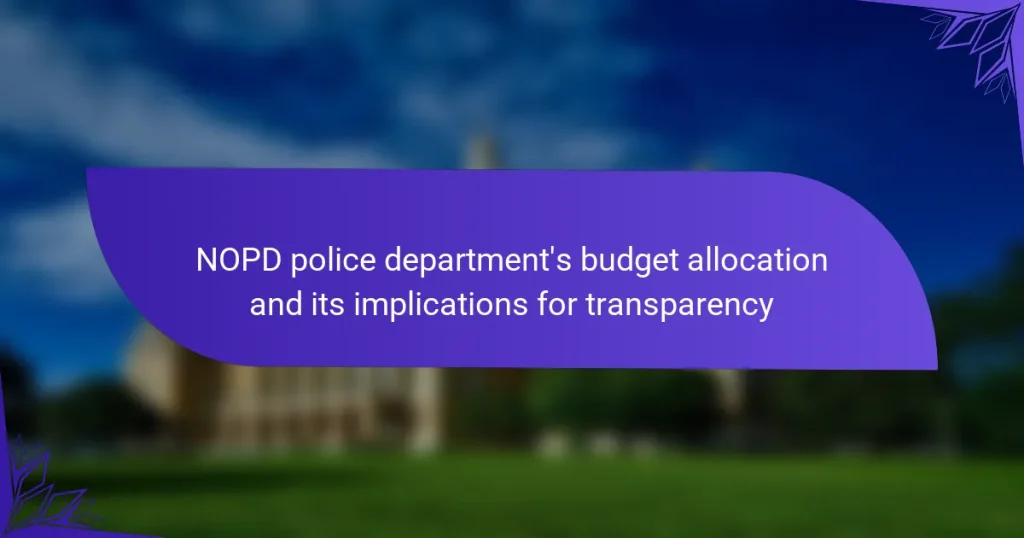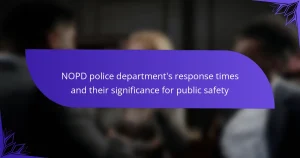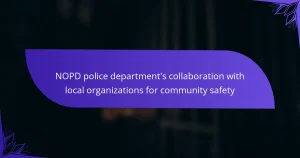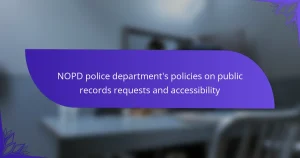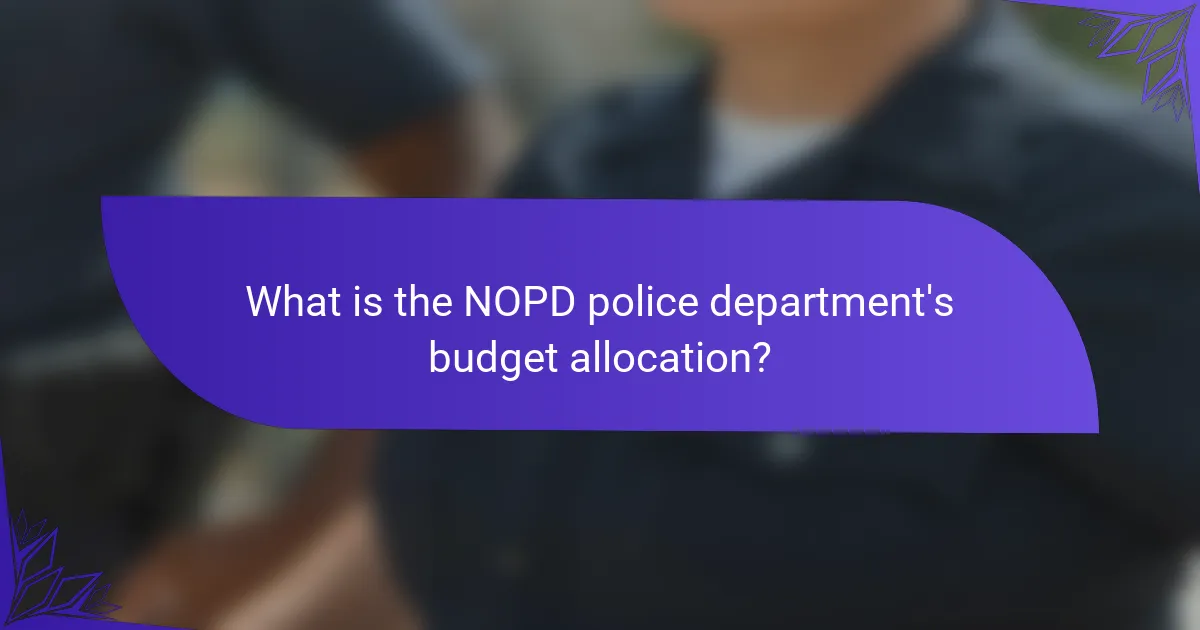
What is the NOPD police department’s budget allocation?
The NOPD police department’s budget allocation for the fiscal year 2023 is approximately $200 million. This budget covers personnel costs, equipment, and operational expenses. Personnel costs make up the majority of the budget, reflecting the need for staffing and training. The allocation also includes funding for community policing initiatives and technology upgrades. Historical data shows that budget allocations have fluctuated over the years. In 2022, the budget was around $190 million, indicating a slight increase. This increase aims to enhance public safety and community engagement. The budget allocation is subject to public review and input, promoting transparency in financial decisions.
How is the budget for the NOPD determined?
The budget for the NOPD is determined through a collaborative process involving city officials and the police department. This process includes the submission of budget requests by the NOPD to the city administration. The city administration reviews these requests alongside financial forecasts and priorities. Public safety needs and crime statistics also influence budget considerations. The proposed budget is then presented to the City Council for evaluation. The City Council holds public hearings to discuss the budget. After deliberation, the City Council votes to approve or modify the budget. This process ensures that the budget reflects both departmental needs and community input.
What are the key components of the NOPD budget?
The key components of the NOPD budget include personnel costs, operational expenses, and capital expenditures. Personnel costs account for the majority of the budget, covering salaries, benefits, and training for officers. Operational expenses include costs related to day-to-day functions, such as equipment, supplies, and vehicle maintenance. Capital expenditures involve funding for long-term investments, such as facility upgrades and technology improvements. In recent years, these components have been scrutinized for their impact on community policing and transparency in financial allocations. The budget is typically reviewed annually by the New Orleans City Council, ensuring oversight and public input in the financial planning process.
How does the budget allocation affect departmental operations?
Budget allocation directly impacts departmental operations by determining resource availability. Adequate funding allows departments to hire staff, purchase equipment, and implement programs. Insufficient budget can lead to understaffing and limited operational capacity. For example, a study by the Police Executive Research Forum found that departments with higher budgets reported better response times and improved community relations. Conversely, budget cuts can hinder training and development opportunities, affecting overall performance. Thus, budget allocation plays a crucial role in shaping the effectiveness and efficiency of departmental operations.
Why is budget transparency important for the NOPD?
Budget transparency is important for the NOPD because it fosters accountability and public trust. Transparent budget practices allow citizens to see how funds are allocated and spent. This openness can reduce corruption and misuse of resources. It also enables community members to engage in discussions about policing priorities. Studies show that departments with transparent budgets often receive greater public support. For example, the National Institute of Justice emphasizes that transparency can lead to improved police-community relations. Overall, budget transparency is essential for effective governance and enhancing the legitimacy of the NOPD.
What are the implications of budget transparency for public trust?
Budget transparency significantly enhances public trust in government institutions. When budgets are clear and accessible, citizens can understand how funds are allocated. This understanding fosters accountability among officials. Research shows that transparency reduces corruption and increases civic engagement. A study by the World Bank found that countries with transparent budgeting processes have higher levels of public trust. Moreover, transparent budgets allow for informed public discourse on spending priorities. This discourse encourages community involvement in decision-making processes. Ultimately, budget transparency builds a stronger relationship between the government and its constituents.
How does budget transparency impact community relations?
Budget transparency positively impacts community relations by fostering trust and accountability. When a police department clearly communicates its budget allocations, it allows the community to understand financial priorities. This transparency can lead to increased public engagement and collaboration. According to a study by the International City/County Management Association, transparency in budgeting enhances citizen satisfaction. Communities that feel informed are more likely to support local initiatives. Furthermore, transparent budgets can reduce misinformation and speculation about police spending. This clarity helps to build a stronger partnership between the police and the community they serve.
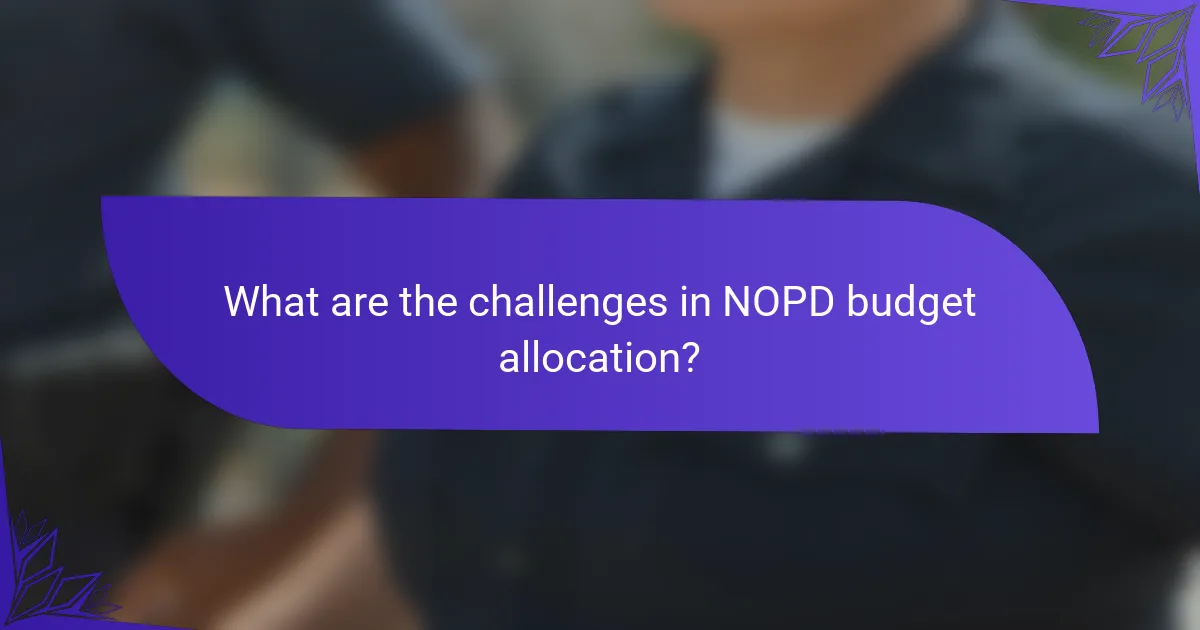
What are the challenges in NOPD budget allocation?
The challenges in NOPD budget allocation include limited funding, competing priorities, and transparency issues. Limited funding restricts the department’s ability to hire and retain officers. Competing priorities can divert resources away from essential services. Additionally, transparency issues can lead to public distrust and hinder community support. These challenges affect overall departmental effectiveness and public safety.
How do funding cuts affect the NOPD’s effectiveness?
Funding cuts negatively impact the NOPD’s effectiveness. Reduced budgets lead to fewer officers on the streets. This results in longer response times to emergencies. Decreased funding also limits training opportunities for officers. Limited resources hinder the ability to investigate crimes thoroughly. A lack of funding affects community engagement initiatives. Lower morale among officers can occur due to budget constraints. Research indicates that cities with better-funded police departments report higher public safety levels.
What areas of the NOPD are most impacted by budget cuts?
The areas of the NOPD most impacted by budget cuts include patrol divisions, specialized units, and community outreach programs. Budget cuts have led to reduced staffing levels in patrol divisions. This affects response times and overall public safety. Specialized units, such as narcotics and homicide, have also seen funding reductions. These cuts hinder their operational effectiveness. Community outreach programs, which build relationships with citizens, face significant funding challenges. This limits their ability to engage with the community effectively. Overall, these areas suffer due to decreased financial resources, which impacts the NOPD’s operational capabilities and community relations.
How can the NOPD mitigate the effects of budget reductions?
The NOPD can mitigate the effects of budget reductions by prioritizing resource allocation and enhancing community partnerships. Implementing strategic planning can help identify critical areas needing funding. This includes focusing on data-driven policing to optimize patrols and investigations. Additionally, seeking alternative funding sources, such as grants and community donations, can supplement the budget. Collaborating with local organizations can foster support and resources. Engaging in transparent communication with the public can build trust and encourage community involvement. Historical context shows that departments utilizing these strategies have successfully navigated financial challenges.
What role do stakeholders play in the NOPD budget process?
Stakeholders play a crucial role in the NOPD budget process. They include community members, advocacy groups, and city officials. These stakeholders provide input on budget priorities and resource allocation. Their involvement ensures that community needs are represented. Stakeholders participate in public meetings and hearings. They can influence decisions through advocacy and feedback. This engagement promotes transparency in the budgeting process. Additionally, stakeholder input can lead to more accountable spending of public funds.
How do community organizations influence budget decisions?
Community organizations influence budget decisions by advocating for specific funding priorities. They mobilize community members to voice concerns and needs. This grassroots pressure can lead to increased funding for local programs. Organizations often conduct research to support their claims. They present data to decision-makers, highlighting community needs. Public hearings provide a platform for these organizations to express their views. Engaging with local government officials fosters relationships that can sway budget outcomes. For example, a study by the National League of Cities found that community engagement significantly affects budget allocations.
What is the role of local government in budget allocation?
Local government plays a crucial role in budget allocation. It determines the distribution of financial resources for various community services. Local governments assess community needs and prioritize funding accordingly. They create budgets that reflect these priorities, often involving public input. This process ensures transparency and accountability to constituents. Local governments must also adhere to state and federal regulations in budget planning. They regularly review and adjust budgets based on changing circumstances and community feedback. Overall, local government acts as a steward of public funds for community welfare.

What are the best practices for improving NOPD budget transparency?
Best practices for improving NOPD budget transparency include regular public reporting of budget allocations. This should involve detailed breakdowns of expenditures and funding sources. Engaging the community through public forums can enhance understanding and trust. Utilizing online platforms for real-time budget tracking is crucial. Implementing independent audits can provide objective assessments of financial practices. Training staff on transparency standards ensures consistent communication. Collaborating with local organizations can foster greater accountability. These practices align with increasing demands for transparency in law enforcement budgeting.
How can the NOPD enhance public engagement in the budget process?
The NOPD can enhance public engagement in the budget process by implementing community forums. These forums allow residents to voice their concerns and suggestions regarding budget priorities. Additionally, the NOPD can utilize digital platforms for broader outreach. Online surveys can gather feedback from a wider audience. Regular updates on budget proposals should be shared transparently. This fosters trust and encourages ongoing dialogue with the community. Engaging local organizations can also facilitate outreach efforts. By collaborating with these groups, the NOPD can reach diverse populations. Overall, these strategies promote inclusivity and transparency in the budgeting process.
What tools can be used to communicate budget information effectively?
Effective tools for communicating budget information include spreadsheets, presentation software, and budget management software. Spreadsheets allow for detailed data organization and analysis. They enable users to create charts and graphs for visual representation. Presentation software helps summarize budget information for stakeholders. It facilitates the sharing of key insights in a clear format. Budget management software provides real-time tracking and reporting. This software often includes features for collaboration and feedback. These tools enhance transparency and understanding of budget allocations.
What lessons can be learned from other police departments regarding budget transparency?
Lessons from other police departments regarding budget transparency include adopting clear communication strategies. Departments like the Seattle Police Department have effectively used public dashboards. These dashboards display real-time budget data and expenditures. Transparency fosters community trust and accountability. The Chicago Police Department implemented community engagement initiatives. They involve citizens in budget discussions. This practice encourages feedback and enhances transparency. Additionally, the Los Angeles Police Department conducts regular audits. These audits ensure financial integrity and public reporting. Such measures promote trust and improve public perception of police funding.
Which departments have successfully implemented transparent budgeting practices?
It is not possible to provide a definitive answer to the question regarding which departments have successfully implemented transparent budgeting practices. There is no specific data or comprehensive list available that identifies these departments. Each department’s success in transparent budgeting can vary widely based on numerous factors, including policies, governance, and community engagement.
What strategies can the NOPD adopt from these examples?
The NOPD can adopt community engagement strategies to enhance transparency. Building regular communication channels with residents can foster trust. Implementing participatory budgeting allows citizens to have a say in budget allocation. Utilizing data analytics can improve resource allocation and accountability. Establishing an independent oversight committee can provide unbiased evaluations of budget use. These strategies have been effective in other departments, demonstrating their potential benefits. For instance, cities like Seattle have seen improved community relations through such initiatives.
What steps can citizens take to advocate for better NOPD budget transparency?
Citizens can advocate for better NOPD budget transparency by organizing community meetings. These gatherings can foster discussion on budget allocation and priorities. Citizens should also attend city council meetings to voice their concerns directly. Engaging with local media can amplify their messages about the need for transparency. Forming coalitions with other advocacy groups can strengthen their efforts. Utilizing social media platforms can raise awareness and mobilize support. Citizens can also submit public records requests to access budget documents. Lastly, they should encourage elected officials to prioritize transparency in their policies. These steps collectively promote accountability in the NOPD budget process.
The main entity of this article is the NOPD (New Orleans Police Department) and its budget allocation. The article provides a detailed examination of the NOPD’s budget for the fiscal year 2023, amounting to approximately $200 million, highlighting key components such as personnel costs, operational expenses, and capital expenditures. It discusses the budget determination process, the importance of transparency in building public trust, and the challenges faced in budget allocation, including funding cuts and competing priorities. Furthermore, the article explores best practices for enhancing budget transparency and the role of community engagement in shaping budget decisions.
